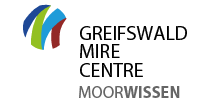Paludiculture Newsletter 3|2025
General information on peatlands and paludiculture
3 new funding programme for paludiculture projects
Paludiculture in practice, young scientists, water and nutrient management – new calls for proposals will be issued in October. Ideas can be developed and submitted until the end of January 2026.
The Federal Ministry of Agriculture, Food and Rural Affairs (BMLEH) wants to further promote climate protection through peatland conservation and is intensifying its research funding. The three calls for funding address paludiculture management techniques, water and nutrient management, and young scientists.
Funding for Research into innovative cultivation techniques for paludiculture is intended to support practical research with rapidly available technology and knowledge transfer in the field of land management and the extraction of renewable raw materials from paludiculture. The Ministry is offering young researchers up to five years of funding for the collection and modelling of data on rewetted peatland sites. Funding for Water and nutrient management of paludiculture is intended to generate knowledge on the hydrology and nutrient supply of wet petalands and paludiculture at the regional level.
Agriculture on Europe's peatlands?
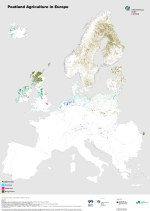
Vast amounts of CO2 from agriculturally used land throughout Europe – but where exactly are they originating from? This new map shows the hotspots.
Across Europe many wetlands are drained for agriculture, releasing vast amounts of CO₂ into the atmosphere. Identifying where these drainage “hot spots” occur—whether for arable crops or grassland—is critical to promoting wet alternatives such as paludiculture.
As part of the project Building the European Peatlands Initiative: A Strong Alliance for Peatland Climate Protection in Europe, researchers have combined the latest European Wetland Map with land cover data to produce a new map showing the agricultural use of peatlands in the European Union and several neighboring countries. This map offers valuable insights for policymakers, conservationists, and the interested public seeking sustainable solutions. The map is based on data from the Global Peatland Database (GPD), which collates and integrates data on location, extent and drainage status of peatlands and organic soils worldwide and for 268 individual countries and regions.
The project is part of the European Climate Initiative (EUKI), funded by the German Federal Ministry for Economic Affairs and Energy (BMWK) and implemented by the Deutsche Gesellschaft für Internationale Zusammenarbeit (GIZ) GmbH. Project partners include Eurosite, CEEweb and the European Landowners’ Organization (ELO).
Participate now in 2 surveys on paludiculture
What future prospects do farmers and landowners in Germany and Europe see for peatlands and what value chains for paludiculture? Two surveys allow you to contribute your own opinion and interest.
The EU Horizon project Paludi4All is currently evaluating important crops with high potential for paludiculture in temperate zones. Through a survey (in English), the project aims to determine, for example, which paludiculture crops are most common in Europe and whether there are already uses for them. It is aimed at researchers, practitioners, policy makers, and interest groups in the fields of land use, agriculture, and the environment. The responses will be incorporated into future fact sheets and life cycle analyses of the project.
Researchers at Georg August University in Göttingen are interested in the perspectives of landowners and farmers on peat soils, especially after rewetting. The aim is to gain a deeper understanding of the challenges involved in rewetting and to derive recommendations for measures. Anyone affected can take part in their survey (in German), regardless of whether they own or manage peatlands. The survey takes about 15 minutes to complete. Those who complete the survey in full will have the chance to win a construction site radio in a prize draw.
Paludi Summer School 2026
A nine-day summer school in June 2026 will offer PhD candidates and early-career researchers the opportunity to gain expertise and network.
From 8.- 17. June 2026, the Paludi Summer School will take place at the Thünen-Institute in Braunschweig and at the Greifswald Mire Centre. It is primarily aimed at PhD candidates and other early-career scientists involved in PaludiNetz projects. Remaining places will be allocated to applicants outside the PaludiNetz in a second selection process.
A central goal is to strengthen interdisciplinary exchange and to network participants both with each other and with experts from research and practice. The focus is on jointly developing and deepening knowledge about paludiculture. The programme is supplemented by practical tasks, interactive workshops and excursions to project sites, rounded off by a number of leisure activities that provide opportunities for exchange and networking. Each participant is asked to give a presentation on their own research topic – an opportunity to share ideas, receive feedback and learn from each other.
Registrations are open until 31 December 2025 via this form. The Paludi Summer School is organised by the project PaludiZentrale.
The Paludiculture Interview
The double life of paludibiomass through cascading-use

Environmental engineer Dr. Karina Brown aims to unlock the diverse utilization potential of paludibiomass through cascading-use. Used as bedding in barns, this plant material – enhanced by poultry manure – becomes a promising feedstock for biogas plants. The possibility to generate additional income through the cascading-use of paludibiomass could improve the profitability of paludiculture for farmers, which is currently under investigation.
Ms. Dr. Brown, paludibiomass from the poultry farm for energy in agricultural biogas plants – how do you research this? Do you get a load of manure delivered every day?
No, not quite. Pellets were produced from one ton of paludihay using various processing methods at the Leibniz Institute for Agricultural Engineering and Bioeconomy e.V. (ATB) in Potsdam within the BLuMo moor pilot project, with which we cooperate as WetNetBB. This work was supported by close cooperation with a regional farmer from the Rhinluch region. On a poultry farm, pellets of varying quality were then used as bedding material. Once the pellets had been saturated with the animal excrement, samples of the bedding material were taken from the experimental barn. The biogas production potential was then determined in the ATB laboratory. Worldwide standardized measurement methods exist for this purpose.
Biomass from peatlands is relatively low in energy, but could become an energy “supersource” when combined with poultry manure—why is that?
Perhaps not a “supersource”, but certainly an interesting alternative to other currently used agricultural biogas feedstocks. That is at least our starting point. Energy production from paludibiomass is no easy task, as previous research has shown. This is related both to the chemical structure of the biomass itself, which is difficult to digest, and to its chemical composition. This, in turn, affects not only the quantity but also the quality of the biogas produced. Biogas consists mainly of carbon dioxide and methane. Our focus is on the methane, the energy carrier in biogas. We aim to maximize its yield, which is also achieved through its utilization as bedding in livestock farming. As our results show, using bedding material enriched with animal excrement improves the stability of the methane production process.
But why not simply put the paludibiomass in the barn as straw? Doesn't the intermediate step of pelleting make it more complicated for farmers?
There are several advantages: Pellets absorb liquids much better than straw. This means that bedding in the form of pellets doesn't need to be exchanged as often – a clear benefit for farmers. Thanks to pretreatment step, pelleted bedding is also microbiologically safe and can therefore be used safely in animal husbandry. Furthermore, a pellet production process allows us to obtain a product that is easier to store and transport without any loss of quality. Pelletizing offers farmers greater flexibility and the opportunity to diversify their income. They can sell some of the pellets or use the press to produce other pellet products, such as fuel pellets.
Would this concept be financially viable?
The economic viability of cascading-use in the presented form must be examined on a case-by-case basis. Whether such a utilization ultimately proves worthwhile depends, among other things, on the quality of the pellets produced. In other words, the crucial question is whether the energy required for pelleting and the energy recovered from bedding pellets at least balance each other out. To determine this, the anaerobic digestion process must first be optimized. Only then we can say whether a cascading-use of paludibiomass is economically viable.
Reed, cattail, sedges – what actually goes into the tank for your experiment?
In our project WetNetBB we focus on the wet meadows biomass, which is very heterogeneous. The vegetation depends on the water level and is shaped by natural succession. This is not material from just a single plant species.
How did you get into this research?
During my PhD in Poland, I already dealt with various energy crops that are considered hardly digestible in biogas production. My research experience shows that this poor digestibility can be improved, for example through pretreatment, cascading-use, or co-digestion. Given the associated possibilities - such as extended usage - it makes perfect sense to examine this topic in the context of paludiculture.
What outcome would you like to see for your research? I'm not here to make any wishes. As a scientist, I provide farmers with a solid foundation based on reliable research results, enabling them to make informed decisions about whether such cascading-use is an attractive business model for them or not.
Dr. Karina Brown investigates at the Leibniz Institute for Agricultural Engineering and Bioeconomy e.V. (ATB) as part of the WetNetBB project the use of paludibiomass in existing agricultural biogas plants. This work is carried out in close cooperation with the BLuMo project on the material use of paludibiomass.
News from paludiculture projects
MOOSland: the great spread
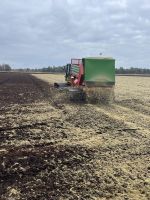
The MOOSland project is promoting peat moss paludiculture with an improved greenhouse gas balance. In September, the project team sowed seeds on a further 6 hectares of land.
The cultivation of peat moss biomass in paludiculture on rewetted bog grassland and the use of peat moss biomass as a peat substitute has been researched and developed for over 20 years. The field trial areas in Hankhauser Moor (Ammerland district, since 2011) and Barver Moor (Diepholz district, since 2020) have now been expanded by a total of approx. 6 hectares as part of the MOOSland model and demonstration project. In contrast to previous projects, less topsoil was removed, fewer driving dams (only as boundaries for an area) were installed and smaller irrigation structures were created. This is intended to further reduce greenhouse gas emissions, which are already significantly lower than in bog grassland (from approx. 32 to approx. 10 t CO2 eq. ha-1 a-1 including harvesting, cf. Daun et al. 2023).
MOOSland is now investigating how peat mosses grow in this new production system compared to the old one and what effects this has on the greenhouse gas balance, biodiversity, hydrology, nutrients, economy, etc. The two sites differ in terms of climatic and hydrological conditions, which will ultimately be used to derive measures for the successful implementation of peat moss paludiculture and its limitations in a handbook.These demonstration areas also serve as visual aids for numerous interested groups and, in particular, for the parallel stakeholder process taking place in the two districts. MOOSland also aims to encourage more farmers to cultivate peat mosses on their land using paludiculture. Profitability is a decisive factor here, which is why political control and incentive instruments should be created.
Further information can be found on the newly designed project website www.moosland.net.
From seed to roof – reed cultivation in Bargischow
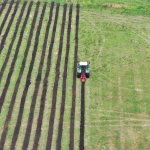
In 2025, the Paludi-MV project was (almost) all about reeds: collecting panicles and threshing them in winter. From May onward a nursery grew plants from the seeds obtained. Then the grand finale in summer: we planted 80,000 young plants on 11 hectares of the project area.

In early summer 2025, construction work to rewet the Bargischow South polder was completed – one of two project areas of the Paludi-MV project. As part of the pilot implementation of paludiculture on the approximately 520 hectares, an 11-hectare section of the polder was planted with young reed plants. There is an established value chain for roof reeds, with two thatched roofers located in the immediate vicinity of the project area.
Planting began in mid-July with the preparation of the planting beds. Two approaches were implemented for this: full-area (2 hectares) and partial (9 hectares) tilling of the topsoil. The tilling was intended to reduce competition from existing vegetation, including reed canary grass, tall fescue, and honey grass, on the young reed plants. A total of 80,000 young plants were then planted by hand in holes prepared with earth augers. Under very good conditions, the planting operation managed to plant around 7,000 plants per day. Depending on the micro-relief (altitude) and competitive pressure, different planting densities of 0.5 or 1 plant/m² were used.
After planting, the water levels in the sub-areas were raised by irrigation from the receiving watercourse using a sluice structure. A high water level – close to the field with temporary flooding – is intended to weaken the existing vegetation on the planted areas and promote the growth of the reed plants. During the planting period, irrigation using mobile pumps was only possible in the peripheral areas and involved considerable effort. Rainfall and moderate temperatures temporarily reduced the need for additional irrigation of the young plants. Following the raising of the water level, the impoundment is regularly monitored and regulated.
While sowing took place at the beginning of May and was the same for all plants, the reeds were planted in stages. The reason for this was the time-consuming work of separating the plants (pricking out). As a result, the first batch already had large root balls and rhizomes in mid-July, while the root balls of the later batches fell short of expectations. Due to the staggering, planting continued until September 10, shortening the growth period, especially for the less developed plants.
In order to evaluate the success of the measure and its various effects on the reed plants, the condition of the plants is monitored regularly. Every second plant is inspected on a total of ten transects across the rows of plants, and specific criteria such as pests, new leaves, dead leaves, or new shoots emerging from the ground are recorded. More details will follow in the project newsletter and at www.paludi-mv.de.
The joint project between Landgesellschaft MV and the University of Greifswald is part of the ZUG gGmbH pilot project for peatland soil protection and is funded by the Federal Ministry for the Environment.
World of paludiculture gathering
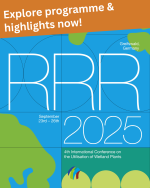
At the 4th RRR conference for climate solutions and economic innovation from wet peatland use 350 international participants spent 4 fruitful days at Greifswald
Fully booked, the RRR2025 - Renewable Resources from Wet and Rewetted Peatlands with its transdisciplinary profile combined cutting edge peatland science with knowledge transfer to economy and politics and practical implementation. Organised by the Greifswald Mire Centre and the Thünen-Institute, it was complemented by a spectacular exhibition showcasing pioneering paludiculture products on both the supply and demand side, from small-sized farming to large scale industry. Besides a packed programme of three parallel sessions, 14 workshops and six excursions the RRR2025 also looked beyond a scientific angle. With a societal and cultural perspective and not without humour it featured excursions, arty side events and an entertaining “Great Paludi-Show” – all documented in the Book of Abstracts.
“This year’s RRR is already the 4th conference of this series since 2013. The term paludiculture itself was coined more than 25 years ago in Greifswald. In recent years, we’ve seen a tremendously growing awareness and interest in paludiculture. Given its relevance for society in general and for climate change mitigation in particular, we should make every effort for large scale implementation. That’s why we are thrilled to provide a platform at RRR2025 for exchange also on the latest trends, especially on how farmers, companies, scientists and even arts are picking up on it.” Dr. Franziska Tanneberger welcomed the guests as co-director of the Greifswald Mire Centre and Winner of the 2024 German Environmental Award speaking for the RRR2025 organising team.
One of the highlights of the RRR2025 conference was the Paludiculture exhibition. Here researchers, landowners, and businesses were gathered to showcase groundbreaking projects and products related to paludiculture. Additionally the comprehensive Paludi Product-Catalogue was launched. Both clearly showed: There is a market for it!
Politics were another conference focus, since paludiculture cannot thrive without firm framework conditions. That’s why the RRR2025 dedicated entire sessions exclusively to politics and governance, touching upon topics such as international climate summits over EU-GAP-regulations or national restoration plans.
RRR2025 placed a strong emphasis on translating theoretical knowledge into practical applications. Numerous hands-on workshops provided attendees with actionable insights about stakeholder groups and communication, innovative monitoring methods and biomass processing. Focusing e.g. on Mycelia bioconversion, vegetation mapping or CO2 certification regulations these workshops will provide the participants insights that they can take the knowledge gained back to their respective fields, promoting the real-world implementation.
Contributions from paludiculture projects from Latvia, East Africa or UK shaped the conference’s diverse international profile making participants profit from each other beyond borders. For Germany the RRR2025 intended to boost paludiculture for those involved in several large scale and long term paludiculture projects throughout the country which share insights and experience in a mostly virtual PaludiNet.
Adding to the dynamic atmosphere of the conference, the “Great Paludi-Show” on the 24th September delivered an engaging, interactive experience for the conference’s community with a dash of humour.
In a transdisciplinary approach the RRR2025 also presented art projects on peatlands and paludiculture. Radio.earth, a participatory art and global acoustic mapping project, let participants immerse themselves in joint listening of live soundscapes of the coastal peatland just outside of Greifswald. There was a screening and filmmaker’s talk of “In Zombie fire - a haunting journey through Europe's forgotten peatlands”.
Peatlands at Futurium
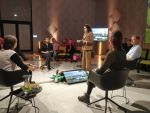
Peatlands in the heart of the capital – there were two such events in October. Visitors were able to discover the ecosystem in a playful way at the Futurium Family Day on 4 October. Experts and the public discussed how interests relating to peatlands can be combined on 9 October.
“More peatland! But how?” – this was the title of an event hosted by Futurium, the Joachim Herz Foundation, and the Greifswald Mire Centre in central Berlin on 9 October. The expert discussion, with visitor participation, focused on the dilemma of land use: peatland are key CO₂ reservoirs but at the same time controversial areas of land. How can climate protection, agriculture, and local interests be reconciled? Moderated by Katie Gallus, Lucas Gerrits, co-founder and managing director of Zukunft Moor GmbH, Juliane Petri, farmer and agricultural consultant from Rhinluch/Kremmen, Dr. Franziska Tanneberger, director of the Greifswald Mire Centre, and René Seltmann, agricultural consultant for peatand soil protection at the Brandenburg State Office for the Environment (LfU).
At the Family Day at Futurium in Berlin on 4 October, the Greifwald Mire Centre presented hands-on activities for the whole family related to peatlands - a campaign in cooperation with the Joachim Herz Foundation (Joachim Herz Stiftung) and Daniel Hengst, the developer of the popular Paludi cuddly plants. There was a lot to discover: informative material such as the Peatland Atlas, information sheets, postcards, and various visual aids. Visitors could cuddle with cattail or peat moss cuddly plants filled with cattail seeds, touch peat mosses and other paludiculture plants, or paint and play with interactive elements. Educators also showed great interest in the range of educational materials, such as the Moorkoffer. There were stimulating discussions with visitors of all ages about paludiculture, peatland ecology, and the value of wet peatlands.
Film series from the MoKKa project – How does rewetting work?

A four-part video series, created as part of the MoKKa project, explains the steps from planning to implementation and what really matters in a rewetting process. The films (in German) are available free of charge on YouTube, each lasting around ten minutes.
The first part of the film series, published by the Succow Foundation within the framework of the MOKKA project, deals with planning and approval and answers questions such as: What does it take to start a peatland project? Where are the biggest challenges – and what tips do experienced project sponsors have to offer? This can be found out in the other parts of the series:
Part 2: Stakeholders & communication:
Here you can find out which stakeholder play a role in a peatland project. How stakeholder communication and decision-making worked in two case studies: in Polder Rochow and Plder Sandhagen. What tips experienced implementers have and how they see the future.
Part 3: Hydrological and technical implementation:
In this part, we'll look at the current challenges for implementing hydrological measures and how climate change is affecting things. We'll also check out the steps taken to raise water levels in different peatland projects. Plus, we'll see what options are available for using the land after rewetting and hear what the interviewees think the future holds.
Part 4: Demand for skilled workers:
This video explains how acute the shortage of skilled workers in the field of peatland restoration already is. It outlines which professions are needed for peatland rewetting and what ideas already exist for improving the situation.
Moorkoffer, the Second
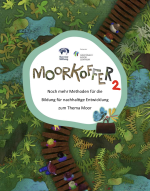
New materials are now available for incorporating more peatand into lessons or environmental education—the new edition of Moorkoffer, a songbook, and instructions for mindful sensory perception.
The Moorkoffer 2 (in german) is not a ready-made suitcase; like the first edition, it is a collection of educational materials on peatlands and climate education intended for teachers, environmental educators, volunteers, and anyone who wants to actively shape education for sustainable development.
The publication contains 50 methods: from soil drilling and role-playing games to experiments, meditations, and creative reflection formats. These methods are flexible, location-based, and adaptable to different needs – they can be used even without access to a real peatland. All materials are freely available and can be used and shared under the CC BY-NC license, meaning non-commercial use with attribution.
Additionally, there's the musical audio play "Im Libellenwunderland" (in german) for children in daycare centers and primary schools, which playfully explores topics such as biodiversity, water scarcity, and climate change. It is available on Spotify, YouTube, and SoundCloud. The booklet “IM.MOOR.SEIN.” (BEING IN THE MOOR), designed to promote mindful sensory experiences in peatlands, guides individuals and groups of all ages through all four seasons. All materials were developed as part of the MoKKa project by the Succow Foundation and the University of Greifswald.
Germany's first student peatland congress

There is a lot of movement around peatlands – as demonstrated by the motto of the 1st Student Peatland Congress, “MooreMotion.” 126 students and young scientists came to Greifswald from 4 to 7September, naturally also interested in paludiculture.
From 4 to 7 September, 2025, the organizing team of the 1st Student Peatland Congress “MooreMotion – ideas flow, communities grow” invited participants to Greifswald. The aim of the meeting was to explore the world of moors together, highlight their potential for climate and nature conservation, and present current research work and innovative practical projects. The congress brought together students from all over Germany, young researchers, practitioners, and experts to discuss perspectives for climate protection, biodiversity, and sustainable regional development – and to focus on paludiculture as a key idea.
Whether in lectures, workshops, or excursions, paludiculture was examined from many angles at the congress:
- “Rewetting through economic efficiency: the potential and challenges of paludiculture” – Ulrika Heller (PaludiAllianz) showed how wet land use can combine peatland and climate protection with raw material production and regional value creation.
- “Agricultural Peatland Use: From Grassland to Paludiculture” (English) – Lucas Gerits (ZukunftMoor, Lower Saxony) presented a practical example of economically successful paludiculture with the world's largest peat moss operation.
- “Saving peatlands through value chains” – In another presentation, Ulrika Heller (PaludiAllianz) highlighted the development of functioning markets for paludiculture raw materials – from production to marketing.
- “Peatland rewetting and biodiversity – potential, limitations, and prospects in the cultural landscape” – Alexander Drexler (University of Greifswald) showed how paludiculture areas can become structurally rich habitats for biodiversity.
- “Peatlands in the GDR and after reunification” – Michael Succow linked the historical development of peatland use with today's approaches to rewetting and paludiculture.
This made it clear that paludiculture is not only an agricultural innovation, but also a key strategy for climate protection, biodiversity, and regional development.
In addition to specialist presentations, “MooreMotion” offered numerous opportunities to experience and discuss the topic of paludiculture hands-on. Workshops were held to jointly develop current projects, technical implementations, and political framework conditions. The excursions to the surrounding peatlands were particularly practical, giving participants direct insights into renaturation areas and model projects in paludiculture.
Space for young talent and new ideas
The congress was explicitly designed as a platform for students and young researchers. In addition to contributions from established experts, there was space for presentations, posters, and discussion rounds in which participants presented their own projects. This created a dialogue on equal terms that not only imparted knowledge but also fostered new networks and ideas for the future of peatlands and paludiculture.
To deepen the exchange, a varied evening program complemented the technical part: readings, film screenings, and quiz rounds created creative spaces to round off the conference days in a relaxed atmosphere.
“MooreMotion” made it clear that paludiculture combines peatlands and climate protection with agriculture, business, and society. The student peatlands congress showed how science, practice, and young ideas can be linked—and provided inspiration for a sustainable future for peatlands landscapes.
Further information on the program can be found at the Congress website or on Instagram.
Events
All current events are compiled in our online calendar.
Publications and literature
Feldmann, T. (2025) Moorkoffer 2 - Noch mehr Methoden für die Bildung für nachhaltige Entwicklung zum Thema Moor. Proceedings of the Greifswald Mire Centre 02/2025 (self-publishing, ISSN 2627‐910X), 191 p. (in German)
Schlacke, S. (2025) Rechtliche Empfehlungen für die Anwendung und Auslegung des Wasserrechts für moorschonende Stauhaltung in Deutschland, unter besonderer Berücksichtigung des Rechts der Länder Brandenburg und Mecklenburg-Vorpommern. Proceedings of the Greifswald Mire Centre 04/2025 (self-published, ISSN 2627‐910X), 69 p. (in German)
Tegetmeyer, C., Kaiser, M., Chobanova, M., Tanneberger, F. & Barthelmes, A. (2025). The European Peatland Map 2025 (‘EPM2025’) - Technical Description and Data Sources. Proceedings of the Greifswald Mire Centre 03/2025 (self-published, ISSN 2627‐910X), 18 pp.
The European Peatland Map 2025 (Download Geodata)







